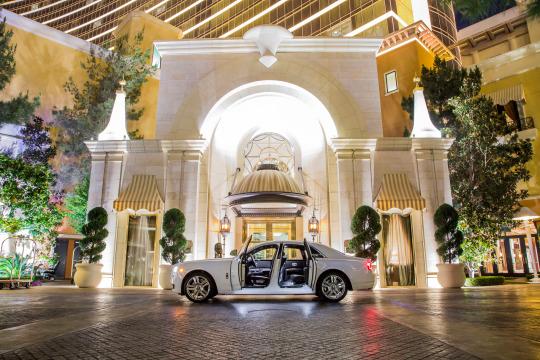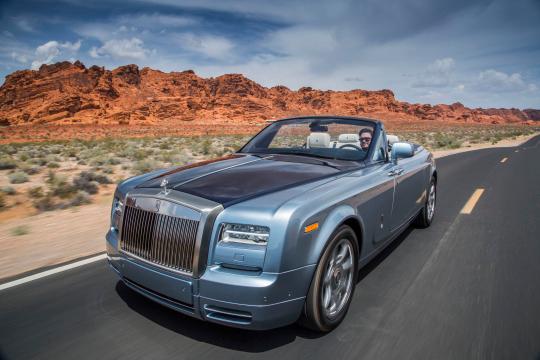Open the rear-hinged “coach door” of the Rolls-Royce Phantom, and you’ll encounter the handle of a full-size umbrella in the edge of the door. You might assume that umbrella is just for foul weather, but as part of Rolls-Royce’s White Glove chauffeur training program, a service now available to customers of the famed marque, you learn what those umbrellas are really for: Paparazzi protection.
Imagine being a chauffeur tasked with extracting or installing a high-profile client. Who happens to be female. In a short skirt. We’ve all seen exeunts gone wrong—hello, Britney—some of which we can’t un-see.

This is but one of many sensitivities we acquired during our day wearing the proverbial (if not actual) White Gloves. Hosted at the decadent, five-star Wynn resort in Las Vegas, Rolls-Royce told us everything from how to dress to how to drive, from how to depart to how to arrive. And even for reasonably good drivers such as ourselves, proper chauffeuring is a lot more involved than simply opening doors and asking, “Where to, madam?”
Our vehicular Professor Higgins was Jamie Clouston, a professional driver and specialist in vehicle dynamics and vehicle risk management. Situational awareness and control is this man’s specialty, but as we found out soon enough, Clouston also had plenty to say about etiquette, grooming, and more. All of which are in the White Glove chauffeur’s job description.
White Glove is not a structured program per se, and there’s no accreditation process, said Clouston. “We don’t have a full curriculum, because whenever these guys go out and do a full training, it’s always specifically tailored to the needs of whoever that owner is. It really is a bespoke option for very particular customers.”
Regardless of the entering skill level of the chauffeurs-to-be, the stated goal is the same: “Ultimately it is your responsibility to make sure that your passengers want for nothing and their journey with you should be effortless and seem to them that they were transported through time on a magic carpet,” says Rolls-Royce.

To Rolls, a chauffeur’s duties begin long before clients ever see the car. The vehicle is spotless each morning, said Clouston, with no item out of place: seatbelts are pressed against the seats; cupholders are concealed; the two-inch-thick sheepskin rugs are debris-free and brushed. Front seats and headrests are identically set for rake and height. Each organ-style vent pull common is at its middle setting, and the sound system is playing a classical station at low volume. And of course, not a spec of dust is visible on any of the vast swathes of chrome, leather, and wood.

Likewise, you are impeccably dressed. “Always look smart,” says Rolls-Royce. Business attire is the standard: a dark suit and a plain dark tie—full Windsor knot, thank you—with a pocket kerchief if possible. Your jacket remains buttoned unless driving, and should be worn at all times except when expressly permitted by passengers. Metal accessories are discouraged, as they could scratch the car when cleaning between trips, but polished dress shoes are a must, preferably with leather soles. The driver may wear sunglasses, though only when driving. And never are they to be placed on the top of the head.
Whatever it takes, the White Glove chauffeur arrives to the pickup location with plenty of time to spare. “If you are on time, you are late,” Rolls-Royce says. When clients appear, you introduce yourself with a handshake to all in the party, including the children, and address each as “sir” or “madam.” Your attitude: upbeat and positive, but not subservient. Relieve the clients of any burdensome luggage, but note that while pulling wheeled suitcases along sidewalks is permissible, never may they be dragged across the street, lest it collect oil or grease. Once next to the car, it is customary to secure the luggage in the “boot” before granting clients access to the vehicle. Indeed, considering the monetary value of the items inside those suitcases, one must ensure that nothing “goes walkabout” while passengers are climbing inside.
After luggage is stowed, you may install the passengers. First, when opening the “coach doors,” do not grip the handle but rather slip your hand behind it and give a slight tug, preventing fingerprints from accumulating on the chrome. With the Phantom’s rear seat being set rather far back, clients often step inside before sitting down — hence the aforementioned need for occasional umbrella protection — and the “principal” client is generally seated diagonally across from the driver, with the secondary client behind the driver. Stand by and hold the door in case there is a strong gust of wind, and keep your eye on traffic should you be on the traffic side of the street. With all aboard, close the door gently until you hear a slight click, at which point the power door closer silently seals the cabin. Oh yeah, and when walking around the car, always walk around the back: according to Rolls-Royce doctrine, walking in front of the “Spirit of Ecstasy” hood ornament is a cardinal sin.

Offer to familiarize guests with the sundry infotainment features, most of which can be controlled via available integrated iPads in the tray tables. Even so, the chauffeur should offer to adjust climate and audio settings to their liking and connect their personal device through the Bluetooth audio system.
Finally—and importantly—before pulling away, make eye contact via the rearview mirror, first with the principal, then with the secondary. Then, then tilt the mirror up and do not look back again. Privacy is paramount, even in the absence of a cabin divider.

Any good chauffeur should know exactly where they’re going and how they plan to get there before greeting the client, but if for some reason the navigation system is required, directions should be viewed via the head-up display and not the dashboard display. Chauffeurs should also know the vital statistics of the car itself—its engine size, power, torque and performance figures. A cheat sheet is acceptable, though only at first.
When time comes to drive, grace trumps pace. When accelerating, never hammer the throttle. “Instead of ‘Ooh we’re accelerating,’ it should feel like, ‘Ooh, slightly more caressing from the sumptuous leather,’” said Clouston. Once up to speed, you never exceed the speed limit, which for driving enthusiasts like us is perhaps the toughest part of the job. “Unless you’re client is saying, ‘Let’s push on a little bit here,’ then never ever break a speed limit,” said Clouston. “That takes an awful lot of discipline—to never ever break a speed limit. Ever try to stick it at a 25-mph speed limit all the way through?” With Clouston aboard, we had to do exactly that, and found ourselves constantly fighting our innate impulse to dip into the Phantom’s boundless power reserves. Yet it beats the alternative of getting a ticket with a client aboard, and prematurely ending one’s driving career.

Handling this three-ton chariot is not difficult; still, there’s plenty to bear in mind. Never clutch the huge, thin-rimmed steering wheel, but rather keep a light grip at the nine-and-three position, or even eight-and-four. Always be on alert for possible hazards, including careless drivers, debris, and onramps. White Glove chauffeurs do not use the Rolls’ adaptive cruise control, as the system lacks the proper finesse. Basically, World War III could be starting around the car, but if the driver has enough situational awareness and reaction time, the rear-seater may never look up from his or her Snapchat.
And no chauffeur lessons would be complete without perfecting the “chauffeur stop,” a handy skill for anyone who’s ever tried to stop a car with sleeping babies or a whiny mother-in-law aboard. The two-step process is remarkably simple: simply press the pedal about ¾ of an inch and then just hold it steady as the car naturally and steadily slows. Then, just before coming to a complete stop, lift your foot very gradually, as if it’s mounted on a cam, for an utterly imperceptible cessation of movement. And if you’re stopping behind another vehicle you should see both “tires and tarmac” over the Phantom’s long hood.
Other dos and don’t for the White Glove chauffeur: never eat, smoke, or sleep in the car. Never text or email while driving. Do not receive or make phone calls except on the client’s behalf, and at that, only via personal earpiece versus the vehicle’s Bluetooth connection. Do not belch or—heaven forbid—pass gas. Only stop to use the restroom when the client asks to do the same. And always, always keep fresh breath. If any of this means that you must alter your diet or quit smoking to do this job, them’s the breaks.
The White Glove program is less than a year old, and is offered to businesses with Phantom fleets (such as the Wynn), dealer groups that want to properly present their cars, or patrons that might want their personal drivers trained at the highest level. Cost is “specified” but is “not an issue,” said Clouston.
“At the end of the day what it has to be is the smoothness of the ride for the rear seat passenger,” said Clouston. “It’s that magic carpet ride, regardless of what is going on. You could have had all sorts of incidents up ahead of you, but that rear-seat passenger shouldn’t know anything about that. Whether you’re braking, accelerating, maneuvering, they should still be able to sip their champagne. In comfort.”

No comments:
Post a Comment